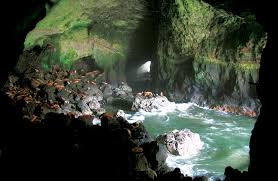 The sixth stop in our series Off The Beaten Path brings travelers to the Sea Lion Caves, located on the coast of Oregon. The privately owned caves are open to the Pacific Ocean and allow easy access for the sea lions that live along the shore. Together these caverns constitute the biggest sea caves in the United States and one of the largest in the world.
The sixth stop in our series Off The Beaten Path brings travelers to the Sea Lion Caves, located on the coast of Oregon. The privately owned caves are open to the Pacific Ocean and allow easy access for the sea lions that live along the shore. Together these caverns constitute the biggest sea caves in the United States and one of the largest in the world.
The Sea Lion Caves are one of the great sea grottoes of the world. It is comparable in coloration and size, to the well known Mediterranean Sea Blue Grotto.
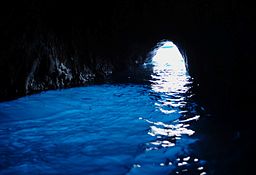
Entrance to the Blue Grotto in Campania, Italy
These particular caves created out of basalt rock, began to form some 25 million years ago.
The caves are near sea level with the Pacific Ocean continually rolling into the main cavern, which has a floor area of about 2 acres or 0.81 hectares. As a comparison, it comprises the length of a typical American football field.
The vaulted rock dome inside rises to about 125 feet or 38 meters high. This is the height of a 12-story building.
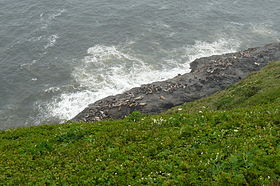
Sea lions with pups outside the caves.
The sea level component of the caves and the adjoining cliff rocks, have over the millennia, become the only mainland rookery and wintering home of the Stellar’s Sea Lion and to a lesser extent, the California Sea Lion.
Although the Sea Lion Caves are the natural home to numerous wildlife, the namesake sea lions gather in the caverns, in the autumn and winter. In the spring and summer they will breed and give birth to their young on the rock ledges, just outside the caves.
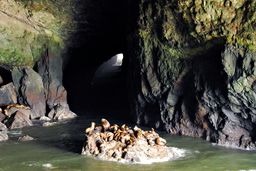
Sea lions inside the caves
There are 3 openings to the enclosure. Southward from the main chamber, a low passage runs 1,000 feet or 300 meters to a sea level opening. This corridor is flooded at high tide and totally free of water at low tide. The western entrance is a rather short high passage, through which the ocean waves wash at all tide levels.
At the north entryway, the passage is about 50 feet or 15 meters above the ocean. This side serves well, as an elevated observation area. From here the entire underground cave system and its remarkable varied wildlife, are the most visible.
 The Sea Lion Caves themselves, were discovered in 1880. They were first observed by a local seaman by the name of Captain William Cox, who entered the chasm through the western channel. He was in a small boat and it was a calm day. He reportedly returned a number of times, to further explore the caves.
The Sea Lion Caves themselves, were discovered in 1880. They were first observed by a local seaman by the name of Captain William Cox, who entered the chasm through the western channel. He was in a small boat and it was a calm day. He reportedly returned a number of times, to further explore the caves.
According to local legend, Captain Cox was once trapped for several days inside the caves, due to stormy weather and turbulent ocean waves. He was able to sustain himself, by shooting a young sea lion and then consuming the meat on its flippers.
Captain Cox would later purchase the land in 1887, from the State of Oregon. His family retained ownership of the Sea Lions Caves until 1926.
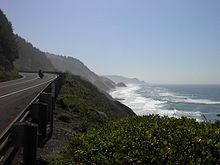
U.S. 101 along the Oregon Coast
In those early days, there were no roads in the area and the surrounding rocky headlands were used mostly for sheep pasture. It made access to the site rather difficult and was only possible by boat.
In 1927, the Sea Lion Caves would be acquired by R.E. Clanton. His intention for the purchase, was to open the caves for public viewing, but he mainly saw it as a business venture.
Mr. Clanton would be blessed later, with the good fortune of having the newly constructed U.S. Route 101, run adjacent to his property.
Once it became likely, that Route 101 would allow tourists easy access to the site of the Sea Lion Caves, Mr. Clanton was able to bring on board, two additional partners, by the names of J.G. Houghton and J.E. Jacobson.

Steps to the caves.
The three men pooled their financial resources, to construct a way to approach the caves by land. As a result, a 1,500-foot (460 meters) pathway, would be excavated by hand into the face of the steep cliff, that towered above the grotto below.
Near the bottom, a 135 step wooden tower was extended down as far as the north entrance to the caves.
The trail and the wooden steps were challenging and quite dangerous to construct, but it finally allowed the Sea Caves to be opened to the public at large, in August of 1932.
Clanton would subsequently withdraw his interest in the partnership as of 1934 and would be replaced by R.A. Saubert.
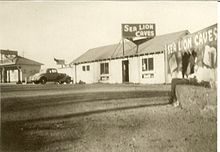
The gift shop in the early 1930s.
Tourism to the site, was not extensive at first. The nearby Highway 101 saw relatively light traffic and remained a gravel road until 1934. As late as 1937, there were still five ferry crossings within 100 miles needed, to traverse Route 101.
The number of visitors did rise steadily however, throughout the late 1930’s.
In 1942, almost all such tourism ground to a halt, as a result of World War II. Gasoline was rationed and car trips to the Sea Lions Caves, came to be seen as a rare event.

In the 1950s
After the war tourism would revive and begin to expand, with the construction of the interstate highway system, inaugurated by President Eisenhower in the 1950’s. The former general, had admired the German autobahn network, in the preceding decade. When he later became president, it was decided the United States would benefit enormously, from a national highway plan.
The number of visitors to the Sea Lion Caves would grow tremendously, with the addition of an elevator in 1961. It took a total of three years to construct, having to be cut out of solid rock. It is able to accommodate a total of 400 people per hour. It has the capacity of 23 passengers per trip.
The elevator can travel 208 feet (63 meters) at 250 feet per minute. This would equate to a speed of 2.8 miles or 4.5 kilometers per hour.
The Houghton, Jacobson and Saubert families would continue the operation of the Sea Lions Caves attraction, until 2006. After that, the Houghton’s would decide to leave the business.
Some interesting points inside the caverns, include the aptly named Indian Maiden, Lincoln’s Head and The Goddess of Liberty. These are formed by the numerous rough surfaces that are covered with algae, lichens and mineral stains. Together, they provide coloration of greens, pinks, purples, reds and yellowish-beige.
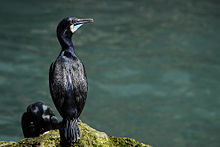
Brandt’s cormorant
The high vault of the main cave area provides a natural resting place, for many species of sea birds. The varieties that can be seen at or nearby the caves, include Brandt’s cormorant, California herring and western seagulls, pigeon guillemot and tufted puffins.
Tourists may also view an occasional bald eagle or hawk.
There is also a whale watching deck, that can be found below the gift shop.

Gift shop at the Sea Lion Caves
This platform permits a seaward view of around 20 miles or 32 kilometers on clear days. At 300 feet in elevation, it has become one of the most popular sites in the area, to view grey whales.
The whales can be seen for most of the year, if a traveler is lucky. Smaller groups will often end their migration and move closer to the shoreline, in an effort to feed.
Orcas may also be seen, but this is only during their regular migration north.
Location
The Sea Lion Caves are located at 91560, Highway 101, Florence, Oregon 97439. The main phone number is (541) 547-3111 and the fax number is (541) 547-3545
The electronic contact is www.sealioncaves.com email info@sealioncaves.com
The gift shop over the Sea Lions Caves, is where you will begin your tour.
Admission
Adults will be charged $14.00 USD (United States Dollar). Seniors will need to pay $13.00 USD. Children aged 5 to 12 are admitted for $8.00 each, with youngsters 4 and below admitted free.
* It is important to remember that all children, must be accompanied by an adult.
Amenities include free parking
How To Get There
Visitors will arrive by using Highway 101, 10.5 miles (16.9 kilometers) north of Florence. The trip will take about 15 minutes depending on traffic. If one is driving south, the Sea Lion Caves are located 38.8 miles (62.4 kilometers) south of Newport, Oregon. It will take about 53 minutes from this community.
If a traveler is driving west from Interstate 5 from Eugene, Oregon, the trip will take 1:31 hours on Route 126 West. The distance traversed will be 71.4 miles or 115 kilometers.
One can also use the Eugene Airport also known as the Mahlon Sweet Field, located 7 miles (11.3 kilometers) northwest of the city of Eugene. It is the 5th largest airport in the Northwest. From there, a tourist can easily rent a car.
Days and Hours of Operations
The Sea Lion Caves are open daily for 363 days a year, from 9:00 am to 5:00 pm. The attraction is closed on Thanksgiving and Christmas. There is an early closure that occurs at noon, on the day before these two holidays.
Lodging
Is available in the nearby community of Florence, which is located to the south of the attraction on Highway 101. To the north on this same highway, one can find lodging in Newport. To the east, travelers can find accommodations in Eugene, located on Route 126.

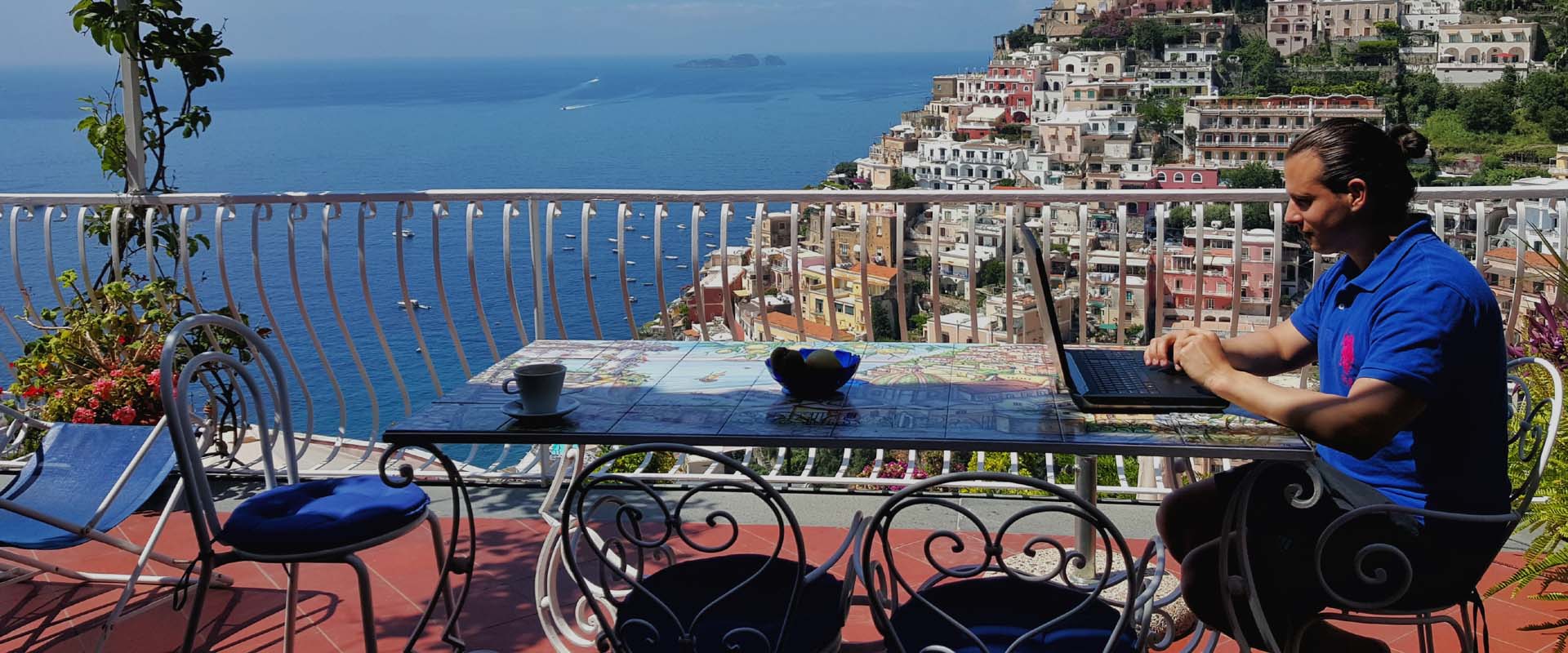
Honestly, it looks scary to me but the sea lions look so cute and friendly so I’m really torn. Haha! More power to you guys!
Thanks for the wonderful post. I am planing to visit next week. Beautiful pictures.